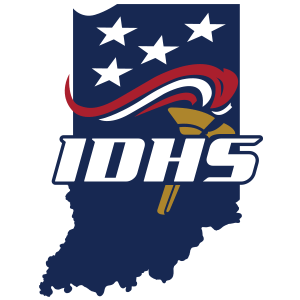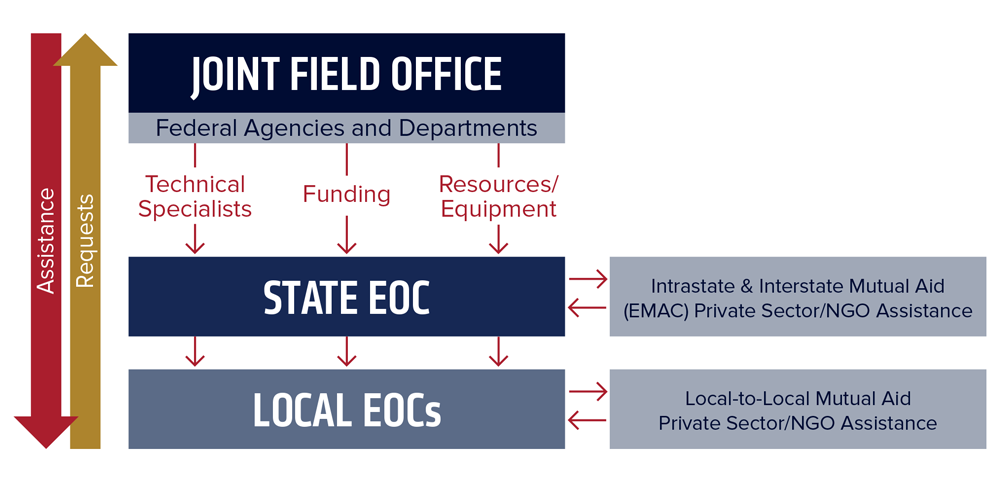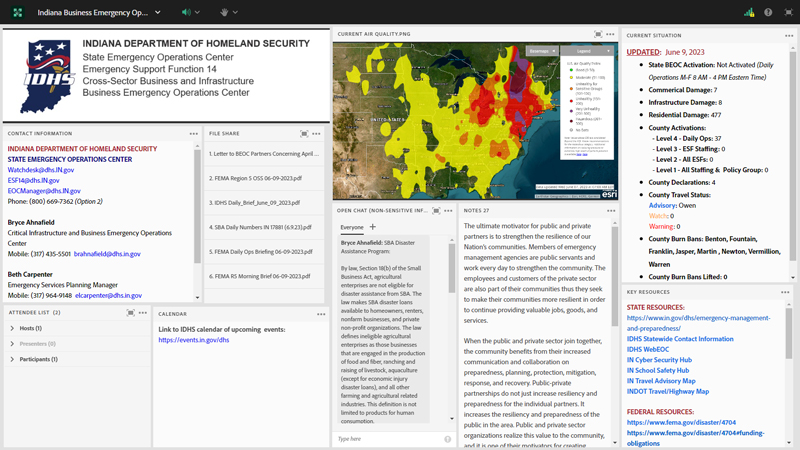Emergency Operations Center
Hours
8 a.m. – 4:30 p.m. Monday – Friday
except state-observed holidays
Indiana Dept. of Homeland Security
Indiana Government Center-South, Room E208
302 W. Washington St.
Indianapolis, IN 46204-2739
Call us: 317-232-2222
Email us: watchdesk@dhs.in.gov
About the State Emergency Operations Center
Tour of State EOC During COVID-19 Activation (2020)
Tour of State EOC During COVID-19 Activation (2020)
Tour of State EOC During COVID-19 Activation (2020)
The State of Indiana Emergency Operations Center (SEOC), located in the Indiana Government Center, functions as a central coordination center for subject matter experts and key organization personnel who facilitate an effective, direct and coordinated response to the needs of the citizens of Indiana in the event of a natural disaster or significant event.
Through the state-of-the-art emergency operations center, the SEOC staff tracks and disseminates late-breaking information gathered from its multiple networks of local, state, federal, private sector, volunteer organizations and emergency management agencies across the state. By working hand-in-hand, all of these organizations can effectively and swiftly respond to disasters small or large, natural or manmade.
The SEOC utilizes a secure internet-based common operating picture, WebEOC, that has more than 4,000 registered users. Each user acts as a “sensor” with the ability to provide timely and critical information. WebEOC is an information-sharing system that provides the ability to effectively communicate, coordinate and support emergency management response activities across the state.
The SEOC is staffed 24/7 by dedicated IDHS employees trained to track developing situations across the state, provide guidance and support to emergency management and first responders, and serve as a round-the-clock contact point with our state, regional and federal partners.
Emergency Classification System
During disasters or emergencies, the SEOC is the Indiana coordination center that allows subject matter experts and key organization personnel from different disciplines to facilitate a synchronized response. The SEOC can be activated at four different levels of response, depending on the severity of the event. For SEOC operating levels beyond Level IV (daily operations), staff from various state agencies can be brought in to assist with emergency management by filling emergency support function (ESF) roles. Each ESF represents a functional grouping of state agencies that are experts in activities often required in emergency management, such as transportation, mass care and logistics. ESFs provide specialized assistance required by the overwhelming impact or specialized nature of a disaster — beyond what local units can sustain alone. Learn more about each ESF on the Planning Section page under State Plans.
| State Response Activation Levels | ||
|---|---|---|
| IV | Daily Operations or Limited Emergency Conditions |
Normal daily operations.
|
| III | Emergency Conditions |
A situation has or may occur which requires an activation increase.
|
| II | Significant Emergency Conditions |
A situation has or may occur which requires an activation increase.
|
| I | Full Emergency Conditions |
A situation has or may occur which requires an activation increase.
|
Support Requests
Another function of the SEOC is the coordination and fulfillment of requests for resources across the state. As local resource capabilities become overwhelmed, county emergency management agencies (EMAs) request support from the SEOC. The resource request process flow is illustrated in the following figure:
Business Emergency Operations Center
Private sector companies can stay in tune with state emergency response operations before, during and after an emergency event by logging on to the Business Emergency Operations Center (BEOC). The BEOC dashboard launched in 2021 and allows the public and private sectors to join together to increase communication and collaboration on preparedness, planning, protection, mitigation, response and recovery.
Working together in the BEOC increases the resiliency of communities and creates a mutually beneficial relationship. Information shared may include road closures, utility service status, ongoing response actions, weather, analysis and more.
When an emergency occurs, the BEOC is the place where private partners can go to get the most up-to-date information from IDHS and share how the event is affecting them. This two-way street means communities will be able to recover faster by pointing out the different ways private sector partners can help and recover.
Private sector partners can check the site daily for updates on what IDHS is monitoring across Indiana and find information like statewide contacts, travel advisory maps and federal resources.
Resources
- Amateur Radio (AUXCOMM)
- Business Emergency Operations Center Dashboard
- Communications and Dispatch
- Incident Management Assistance Team (IMAT)
- Incident Management Teams Credentialing
- Indiana Building Emergency Assessment and Monitoring Team (I-BEAM)
- Mass Fatality Incident Management (IN-MORT)
- State Agencies and Voluntary Organizations
- Volunteering
- WebEOC
- WebEOC Reporting Guidance


